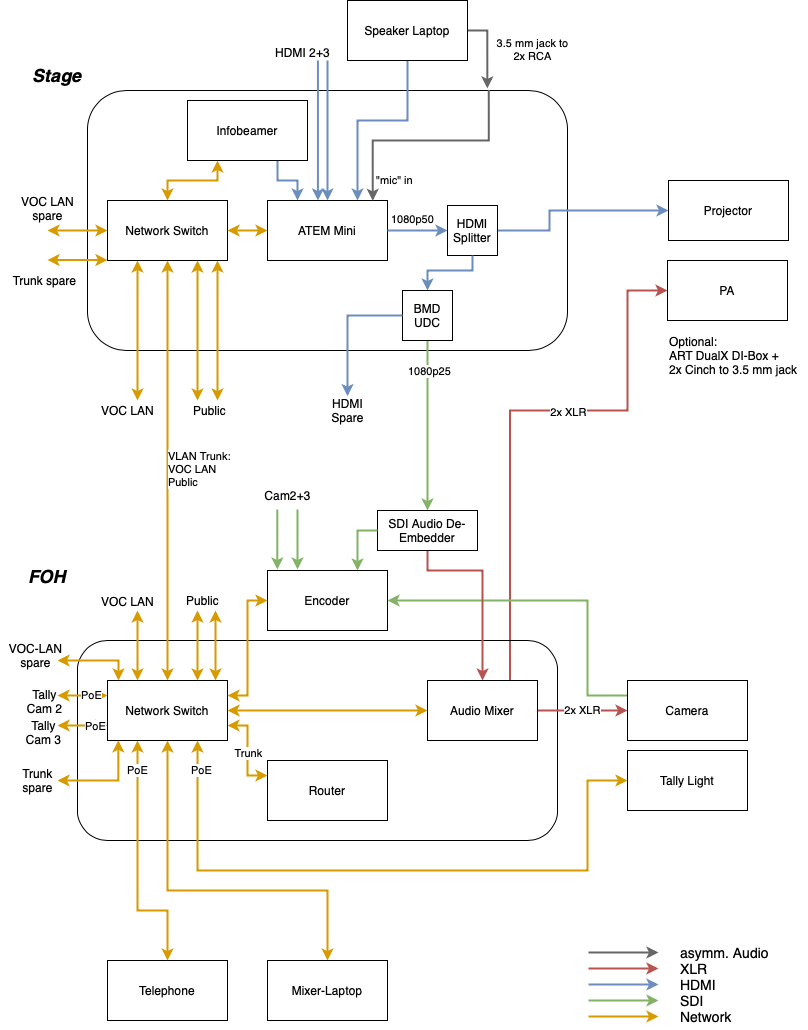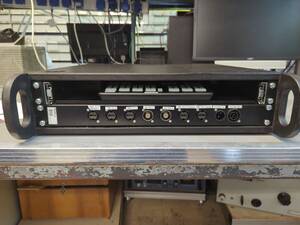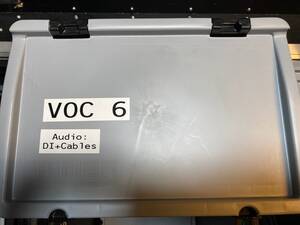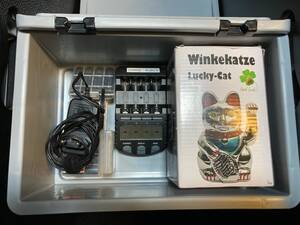Case 2.0
- name:
- Case 2.0
- project-owner:
- Sophie
- git-url:
- https://pad.c3voc.de/MOmd3mvsRbi8y8IdJl1xYA
- project-description:
- Rework of the Lecture Room Cases
- project-member:
- Bix, jtbx, Kunsi, JayJay, Thorti, ...
- project-status:
- in progress
The c3voc has six lecture room case sets which contain everything that's needed to stream and record lectures in some kind of venue. The venue only needs to provide a projector and some kind of speakers / PA besides power and internet access.
As our requirements have changed over the years, all the stuff we carry for every eventuality does only barely fit into the road case (and the two additional boxes we put on top).
- As one of the add-on boxes is wider than the others, they tend to break during shipping.
- Another pain point of the current setup is the vast amount of items (about 240).
We need to be prepared for different ways to connect our setup to the lecture hall (PA and projector), but most of the items are always connected in the same way.
The result is documented in Lecture Room Set 2.0 and below:
Shopping list: https://cloud.cccv.de/apps/files/files/440945?dir=/crew_c3voc/case_2.0&openfile=true
Goals
High-level goals of the project are:
- Optimize buildup and tear-down time by reducing the number of individual items
- Items should be grouped into modules in which the devices are pre-connected
- This reduces wear and tear on connectors, the chance to loose things and the amount of items to track
- The focus should be on the “small” events like FrOSCon, MRMCD, Jugend Hackt and even GPN
- Those use “standard” setups with 1-2 cameras and no fancy setup on the stage
- These events usually have too little experience VOC people available
- Big events like Congress and Camp are special, so don't optimize for that!
Timeline
- …
- April 2024 (Easterhegg): Die AGS hat Flightcases und Module über. Damit werden am Case 2.0 prototype Geekend vom 10.-12. Mai eins der bestehenden Flightcases (Raum 6) auf das neue Konzept umgebaut. Das Geekend wird in Braunschweig stattfinden.
- May 2024: Prototypes were build
- Juni 2024 (GPN): Prototypes will be tested at GPN Karlsruhe
- March 2025: Finalize BoM at a Geekend
Pictures
Requirements
The main purpose of the VOC case is to provide a video stream and recording of lectures:
- Inputs:
- Slides and speaker laptop audio (stereo)
- 1-3 cameras
- 3-4 microphones for native language
- (optional) 1 translation track (mono)
- (optional) additional video sources on stage
- (Infobeamer)
- Outputs:
- Finished video signal on disk and stream
- Signal for the projector (slides/ Infobeamer/ additional camera)
- Audio-mix for the hall (native audio)
So the recommended signal flow looks like this: 
Additional requirements include:
- It shall be possible to “inject” public LAN or VOC-VLAN on any box, which has a network switch
- Use patch panels where possible to reduce the risk of broken connectors on the devices themselves
- Group items by their place in the hall
Building Blocks
With the usual setup and the cabling plan in mind, there are a some basic building blocks:
- Lectern Module: Everything usually setup on stage
- Inputs from speakers
- Output to the hall
- FOH Module:
- Audio mixer
- Connections for mixer laptop and telephone/ intercom
- Connections for one camera
- Encoder Module:
- Can either be placed on stage or at FOH
These modules are like the modules offered by ProCase, see their catalogue: https://www.procase.de/fileadmin/media/_kataloge/19-Zoll-Racks_DE.pdf
Additional crates are needed to store:
- Everything belonging to the camera
- Microphones
- Everything for the FOH workplace (mixer laptop, etc.)
- Random special adapters
TODO:
- The following lists does not include ethernet ports for a possible ethernet-based intercom!
- Should be be prepared for SMPTE 2110 (10G switches (at least some ports), PTP)?
Lectern Module
This module will be placed at the stage near the lectern and contains the interface to “slide” input(s) as well as the connection to the hall's infrastructure (projector and speakers).
Goals
- Switch “slides” signal between speaker laptop, Infobeamer and additional sources
- Output HDMI at 1080p50 for projector
- Output SDI (and HDMI) at 1080p25 for recording
- Convert asymmetric stereo audio input to symmetric signal
Output symmetric signal to hall PA- (Network for all devices in this module + “uplink” + debugging ports)
Design
- Case:
- 2 rack unit module
- 1 drawer
- 1 rack shelf (to mount switch and power supply)
- Devices:
- ATEM Mini (buttons shall be accessible)
- Network switch (8 ports, no PoE required)
- 2 ports trunk for module interconnect (1 spare)
- 2 ports internal for Infobeamer and ATEM Mini
- 2 ports public LAN (1 “input”, 1 for speaker laptop/ debugging)
- 2 ports VOC LAN (1 “input”, 1 for spare)
- HDMI Splitter
- BMD Up Down Cross
- Infobeamer Pi
- Common power supplies for the devices (12V and 5V)
- I/O-Panel (12 ports, at the front side)
- 2x Cinch for speaker laptop (could also be 1x 6.3 mm jack)
- 3x HDMI in to ATEM Mini
- 1x HDMI out to projector
- 1x SDI out to encoder (from BMD Up Down Cross)
- 1x PowerCON in
- 4x Ethernet RJ45
- Internal connections:
- from drawer to front panel: 1.2m
- 4x HDMI (3x Atem Input, 1x Projector)
- 1x SDI
- 1x 3.5 mm jack to Cinch
- from switch to front panel: 0.75m to 1m
- 4x Ethernet
- Additionally:
- Meshbag with speaker adapters (all to HDMI socket): USB-C, USB-C multiport, DisplayPort, Mini-DP, mini-HDMI, micro-HDMI, VGA, DVI
- 2x HDMI Cable 3m (from laptop)
- 1x 3.5mm-Jack to 2x Cinch 3m (from laptop)
- (Cables to hall are listed separately)
Prototype
Built during Case 2.0 Geekend at ags
Differences to Design Spec:
- 12 Port D-Norm Panel instead of 16 due to PowerCon TR1 input - 16 Port Panel is possible, but needs some more modifications
- No Audio Input on the Panel, but 2x SDI out
Power Supply:
A 12V 5A “Laptop Style” Power supply is used to power the whole module. A DC-DC Buck Converter Board creates the 5V for the Infobeamer Pi and the HDMI Splitter. The Power Supply and the Converter are on the Bottom Rack Shelf, a custom made 4 Pair Cable is used to bring the Voltage Rails up to the Drawer and into the Devices.



The drawer has zip Ties that catch on the Panel below to prevent it from extending further than the Atem Mini by default. Slightly lift it to pull it out fully.
FOH Module
This module will be placed at the FOH and includes the audio mixer and microphone receivers as well as additional infrastructure needed at the mixer's position.
Goals
- Provide at least 3-4 audio mixes (from sources listed bewlo)
- Native for recording (just more compression than hall)
- Native for hall (might need additional output EQ)
- n-1 mix to remote speaker(s)
- translation
- Have audio inputs for:
- 4 wireless microphones
- 2 handheld microphones and 2 beltpacks
- max. 4 antennas (use antenna combiner, if necessary)
- Frequency band shall be usable in EU and not be the 800 MHz band already used by the c3voc
- Stereo-input for “slides” audio
- (Stereo-)input for remote speaker(s)
- Mono-input for translation
- Provide VPN access to VOC-equipment in the hall
- Provide enough network ports for all device on this module, the encoder, tally lights, mixer laptop and a SIP phone
Design
- Case:
- 3 rack units on front
- 2.5 rack units for audio mixer (1 above mounting level, 1.5 below)
- → 6 rack unit module rack
- Devices:
- Audio mixer Allen&Heath CQ-18T
- Router (as part of the Mikrotik Switch)
- SDI Audio De-Embedder
- Network switch(es) (14 ports, 4 of them with PoE)
- 2 ports trunk for module interconnect
- 1 port internal for router (VLAN trunk)
- 1 port internal for audio mixer
- 2 ports for encoder PC and mixer laptop
- 3 PoE ports for tally lights
- 1 PoE port for SIP phone
- 2 ports public LAN (1 “input”, 1 for debugging)
- 2 ports VOC LAN (1 “input”, 1 for debugging)
- I/O-Panel top-side (8 ports, 6 used)
- 2 BNC-connectors for receiver antennas
- 2x XLR out with n-1 mix
- 2x XLR out (spare aux ports)
- Brush-Panel top-side + 1 blank panel
- I/O-Panel back-side (8 ports, 5 used)
- 1x PowerCON in
- 1x PowerCON out (additional hole)
- 2x SDI (audio de-embedder)
- 2x XLR out with recording mix
- 3x CEE 7/3 (Schuko) sockets externally accessible (for mixer laptop, camera, battery charger)
- Internal connections:
- 4x 1m XLR (f) to angled XLR (m) (receiver to mxier)
- 6x 1m angled 6.3mm jack to soldered XLR D-norm jack (aux output)
- 2x 1m SDI (audio de-embedder)
- 2x 0.75m Ethernet (switch to audio mixer and wireless receiver)
Encoder Module
The encoder can either be placed at the FOH or at the stage and is therfore contained in a separate module.
Goals
- Contain the encoder PC in a portable enclosure
- Provide a patch-panel for all inputs, so that the connectors on the decklink card are protected against excessive mechanical force
Design
- Case:
- 4 rack units module
- Devices:
- Encoder PC with 4 SDI inputs and 1 HDMI output for local playout
I/O-Panel front-side (10 ports)- 4x SDI in
- 1x HDMI socket
- 1x Ethernet
- 1x PowerCON in
- 1x PowerCON out
Internal connections:- 4x SDI patch
- 1x HDMI patch
- 1x Ethernet patch
- 1x power patch
Microphone Box
To reduce the weight of the FOH/ Audio module, the microphones are stored in a separate crate.
Goals/ Design
- Enough space and foam cutouts for:
- 2 handheld microphones
- 2 beltbacks
- 2 headsets
- TODO: Batteries?
- Cases:
- 1x 40x30x7.5 cm with lid (for microphones)
- 1x 30x20x12 with lid (for batteries, charger and winkekatze)
Camera Box
This crate shall contain all devices usually attached to the camera or tripod. Every item shall have a fixed place, e.g. in a foam cutout.



Goals/ Design
- Cases:
- 1x 40x30x32 with lid
- Devices:
- Camcorder (TODO: Model) with:
- power supply
- battery and battery charger
- Preview monitor with:
- Power supply
- Magic arm
- HDMI cable 1m
- At least 1 tally light
- 4 SD cards
- 3-port power strip? → no, put to other power cables
- Containment: Top-loaded box/ crate
Camera requirements:
- SDI output 1080p25
- HDMI output usable at the same time as SDI
- Zoom range of 15-25x (current Panasonic camcorders: 22x 3,9-86mm (28-616mm KB) at f1.6-3.2)
- Motorized zoom
- 2x SD card slots
- 2x XLR inputs (full size!)
Mixer Laptop Box
- Cases:
- 1x 40x30x12 with lid:
- Devices:
- Mixer laptop with power supply
- Mouse
Additional Boxes
Other stuff










Design
- Cases:
- 1x 30x20x12: Audio Embedder + BiDi
- 1x 30x20x12: DI-Box, etc (ex Audio kurz)
- 1x 30x20x12: Winkekatze + Battery Charger
- 1x 30x20x12: Tally-Light(s)
- 1x 30x20x17: Tape
- 1x 30x20x17: Ethernet short (3m and 5m)
- 1x 40x30x07: Minion
- 1x 40x30x17: Intercom
- 1x 40x30x07: Office (Switch, TBD)
- 1x Sortimentskasten: Stuff from “Meshbag Audio/ BNC Adapter”
- TODO: 1x 30x20x12: DT770 headphones
Cables
We need several cables to connect the different modules and the camera, which weren't already placed in a module/ box. Each cable type shall have a separate box or compartment and all cables shall be marked with their length.
- Cables sorted by place
- lectern module ↔ speaker laptop
- (already listed at lectern module)
- lectern module ↔ hall
- 1x HDMI
- length: 5m
- lectern module ↔ FOH
- 1x ethernet
- 1x SDI
- length: 20m + 10m
- FOH ↔ hall
- 2x XLR
- (fallback to mini jack or cinch via DI box is listed in special adapters)
- length: 20m + 10m
- FOH ↔ camera
- 1x SDI
- 2x XLR
- 1x Ethernet (Tally)
- length: 10m
- for remote
- 2-4x XLR
- 1x HDMI (from preview monitor)
- length: 5m
- FOH ↔ encoder
- 1x SDI
- length: 2m
- power for everything
- 3x 2m Schuko to Powercon (Lectern, Audio/FOH, spare)
- 2x 0,5-1m Powercon to Schuko (z.B. um Encoder an FOH anzuschließen oder Speaker-Strom am Lectern)
- 2x 10m Schuko-Verlängerung
- 2x Steckdosenleiste 6-er (spare)
- 2x Steckdosenleiste 3-er (Kamera, Spare)
- ethernet misc
- 1x uplink (+ 20m worst-case?)
- 1x to Mixer-Laptop
- 1x to phone
- 1x for debugging/ spare
- length: 3m
- misc
- 3x SDI 2m spare
- 2x XLR 10m spare
- (sorted by type and length, ranges include are min to spare)
- SDI
- 1x 20m
- 2x 10m
- 4x 2m
- XLR
- 2-4x 20m
- 4-6x 10m
- 2-4x 5m
- HDMI
- 2x 5m
- 2x 3m (lectern module)
- Ethernet
- 1-2x 20m
- 2x 10m
- 4x 3m
- Power
- 3x 2m Schuko to Powercon (Lectern, Audio/FOH, spare)
- 1x 2m Powercon to C13 (um Encoder an FOH anzuschließen)
- 2x 10m Schuko-Verlängerung
- 2x Steckdosenleiste 6-er (spare)
- 2x Steckdosenleiste 3-er (Kamera, Spare)
- Audio misc:
- 1x 3.5mm-Jack to 2x Cinch 3m (lectern module)
- Containment: Case compartment
To Be Sorted
Additional items in need for a fixed place are:
- Intercom (if not placed elsewhere)
- “Kabelbindertüte” + Pens
- Spare batteries?
- Remote speaker setup (audio interface, HDMI grabber)?
- Tally 2+3 (if not in camera box)
- Presentation clicker?
Discussions
This section contains information why certain aspects of the setup are defined as described above.
Phones in each Case/ Intercom
At first we wanted to include a second phone in each case, so that we can have a VOC office even when the “regie box” was not shipped to the event. But we identified some issues with this concept:
- Telephones only provide a benefit, if somebody is near the office phone all the time
- This is probably not the case on small events with only 1-2 lecture rooms and the VOC people will be around in the venue
- An alternative would be to have some DECTs and an RFP in each case. But the handsets would need to arrive charged, somebody has to set it up, etc.
- So this is a lot of effort for diminishing returns and on bigger events there'll be a POC and/or we can bring our office setup and have enough people to staff a helpdesk
- Intercom will be much more useful even on small events
- Better take the space for the phones to have some intercom
- A wired intercom limited to each hall would be enough
Power Input
- Cables attached to the units are a hassle to store properly
- So use PowerCon sockets on the units and store cables separately
- PowerCON TRUE1 TOP vs “regular” Power CON (blue/grey)
- The new TRUE1 TOP seems like the way to go, but the “output” sockets are too bit for standard D-type patchpanels
- So use the “old” blue/grey PowerCON instead
Cameras
See above for requirements (most notable a decent motorised zoom range).
- Something like a BMD Studio Camera would remove the need for a preview monitor
- But this would need a separate lens, which needs to be transported properly
- BMD Studio Camera: Has MFT mount with limited choice of suitable lenses
- BMD Ursa: Quite big, transport with lens attached is probably a bad idea → not suitable for “untrained” users
- So we're at a camcorder again b/c:
- Single unit
- Easy to operate for new people
- Can also be used handheld quite easily (as a camera on stage)
- Decision: JVC GY-HC500E
Research
Cameras
Prosumer Cameras
There's basically just Sony, Panasonic and JVC. Sony only has camcorders with 1/3 inch sensor, which is not beneficial for low-light performance.
- Panasonic AG-CX350EJ (~2400€ w/o VAT) https://eu.connect.panasonic.com/de/de/products/broadcast-proav/ag-cx350
- 1 inch sensor
- 20x Zoom f2.8-4.5 / 8.8-176mm (24.5-490mm KB)
- F13 / 2000Lx
- BxHxT 180 x 173 x 311mm
- 3G SDI + Full-Size HDMI
- JVC GY-HC500E (~2650€ w/o VAT) https://de.jvc.com/pro/ccr/eng/GY-HC500E/
- 1“-Sensor
- 20x Zoom f2.8-4.5 / 9.43-188.6mm (28mm-560mm KB)
- F12 / 2000Lx
- BxHxT 195 x 230 x 445mm
- 3G SDI + Full-Size HDMI
- Canon XA75 (~2300€ w/o VAT) https://www.canon.de/video-cameras/xa75/specifications/
- 1”-Sensor
- 15x Zoom f2.8-4.5/ 8.3-124.5mm (25,5-382.5mm KB)
- F?? / 2000Lx
- BxHxT 140 x 216 x 265mm
- 3G SDI + Mini HDMI
- Sony PXW-Z190 (~3000€ w/o VAT) https://pro.sony/de_DE/products/handheld-camcorders/pxw-z190#PROR301008Productspecificationsblock-pxw-z190
- 1/3“-Sensor
- 25x Zoom f1.6-?(?) / 3.7-92.5mm (28.8-720mm KB)
- F12 / 2000Lx
- BxHxT 190 x 202 x 420mm
- 3G SDI + Full-Size HDMI
- Sony Kamera ist EOL! Nachfolger: PXW-Z200
- Sony PXW-Z200 (3750 w/o VAT Listprice) https://pro.sony/de_DE/products/handheld-camcorders/pxw-z200#ProductSpecificationsBlock-pxw-z200
- 1”-Sensor
- 20x Zoom F2.8-F4.5 / 7.71-154.21 mm (24-480 mm KB)
- F12 bei 2000LX
- BxHxT 176 x 202 x 372mm
- HD-SDI to 12G-SDI + Full-Size HDMI
Remote Control Zoom/Focus
- Manfrotto MVR901EPLA (~335 w/o VAT) https://www.manfrotto.com/de-de/fernbedienung-lanc-sony-canon-mvr901epla/
- Zoom and Focus
- Support for Canon, JVC, Sony, Panasonic https://cdn.manfrotto.com/media/downloadable/manual/Compatibility-Chart_Manfrotto_Camcorder_April_23.cleaned.pdf
- REC-Button
- Manfrotto MVR901ECPL (~200 w/o VAT) https://www.manfrotto.com/de-de/fernbedienung-sony-canon-und-panasonic-mvr901ecpl/
- only Zoom
- Support for Canon, JVC, Sony, Panasonic https://cdn.manfrotto.com/media/downloadable/manual/Compatibility-Chart_Manfrotto_Camcorder_April_23.cleaned.pdf
- REC-Button
-
- Zoom and Focus
- No Compatibilty List, should work with Sony and Panasonic (test necessary)
- REC-Button
Broadcast Cameras
For comparison, here are some features of Blackmagic Design cameras:
- Blackmagic Studio Kamera 4k G2 (~1.400€ w/o VAT)
- MFT-Mount
- possible lenses (focus and zoom control supported)
- MFT
- Olympus 12–50 mm f/3,5–6,3 ED M. Zuiko EZ Micro 4/3 Objektiv
- Panasonic Lumix G X Vario PZ 45–175 mm f/4,0–5,6 Zoomobjektiv mit O.I.S
- Olympus 14–42 mm M.Zuiko f/3,5–5,6 Digital ED EZ Objektiv
- Panasonic Lumix G X Vario PZ 14–42 mm f/3,5–5,6 Power-Objektiv mit O.I.S.
- with EF adapter
- Canon CN-E 18–80 mm T4.4 Compact-Servo
- Canon CN-E 70–200 mm T4.4 Compact-Servo
- Canon EF-S 18–135 mm f/3,5–5,6 IS USM mit Canon PZ-E1 Power-Zoom-Adapter
- Blackmagic Design URSA Broadcast G2 + Fujinon XA20x8.5BRM-K3 (~6.100€ w/o VAT) https://teltec.de/blackmagic-design-ursa-broadcast-g2-plus-fujinon-xa20x8-5brm-k3.html
- 20x Zoom f1.8-2.7 / 8.5-170mm
- BxHxT 278 x 150 x 252mm body + 85 x 85 x 181mm lens
- 12G SDI (Encoder) + 3G SDI (preview monitor)
Wireless Microphones
Requirements:
- Ideally a quad-channel receiver, dual-channel also fine
- digital transmission
Comparisons based upon 4 channel receiver(s), 2 handsets and 2 headset and antenna splitter where necessary. Per brand similar hand/headset/capsule etc.
Sennheiser (prices are MSRP incl. VAT):
- EW-D:
- only single-channel receivers available
- 2x EW-D SK Base Set: 598€
- 2x ew-D 835-S: 675 €
- 649€ EW-D ASA Splitter
- 185€ the t.bone free solo Antenna Splitter
- Total 2731€ (with t.bone splitter)
- 90 simultaneous transmitters
- 2x AA battery or proprietary battery pack
- EW-DX:
- dual or quad-channel receivers available
- 1099€ per dual-channel receiver (1/2 width, + 300€ for Dante)
- ~3000€ per quad-channel receiver (full width, with Dante)
- ~469 per transmitter (handheld + microphone capsule)
- (dual-channel beltpack set: 2700€)
- (dual-channel handheld set: 2200€)
- 149 simultaneous transmitters
- 2x AA battery or proprietary battery pack
- Comparison dual channel receiver
- 1x Receiver + 2 handhelds https://www.thomann.de/intl/sennheiser_ew_dx_835_s_set_r1_9.htm €2199
- 1x 2 channel receiver https://www.thomann.de/intl/sennheiser_ew_dx_em_2_r1_9.htm €1049
- 2x Beltpack https://www.thomann.de/intl/sennheiser_ew_dx_sk_r1_9.htm €469
- Total €4186 (without splitter)
- 2HE
- Comparison quad channel receiver
- 2x Handheld transmitter https://www.thomann.de/intl/sennheiser_ew_dx_skm_s2_10.htm €459
- 2x Capsule https://www.thomann.de/intl/sennheiser_mmd_835_1_bk.htm €95
- 1x Beltpack https://www.thomann.de/intl/sennheiser_ew_dx_sk_r1_9.htm €469
- 1x Headset https://www.thomann.de/intl/sennheiser_me3_ii.htm €145
- Total €4820
- 1HE
Sennheiser (NL) recommends EW-DX for our use case, mainly because of the large number of available channels within the various bands. Analogue was highly discouraged for the same reason. I (Bix) couldn't get a firm recommendation for frequency band from them, but in NL bands R1-9 (520-607.8MHz) and S2-10 (614-693MHz) were sold the most, in DE Q1-9 (470.2-550 MHz).
Shure:
- SLX-D
- with dual-channel receivers
- 1x SLXD24DE/SM58 (dual channel with 2x SM58): 1629€ MSRP
- 1x SLXD14DE (dual channel with 2x belt pack): 1599€ MSRP
- 1x t.bone splitter: 185€
- Total 3413€ (without splitter)
- with quad-channel receiver
- 1x Shure SLXD4Q+E (quad channel, without Dante): 2685€
- 2x Shure SLXD2/Beta87A (handheld) 469€
- 2x Shure SLXD1 (beltpack) 265€
- Total 4153€
- no encryption
- 32 simultaneous transmitters
- 2x AA battery
- QLX-D
- only single-channel receivers available
- active antenna splitter uses 1U half-width
- 2x QLXD24/SM58 (single channel, SM58): 1404€
- 2x QLXD14 (single channel, belt pack): 1298€
- 1x t.bone splitter: 185€
- Total 5589€
- 60 simultaneous transmitters
- 2x AA battery
- ULX-D
- single-, dual and quad-channel receivers available
- dual- and quad-receivers support Dante
- dual- and quad-receivers antennas can be daisy-chaned
- 17-22 simultaneous transmitters
- 2x AA battery
Audio Mixers
GPN Feedback (DM3 vs. CQ18T): https://pad.c3voc.de/P7ioYJOWT7e3yjQsiq6jEg
- Allen&Heath CQ-12T: https://www.allen-heath.com/hardware/cq/cq-12t/
- 10x XLR in (5 combo jacks) + 1x Stereo in
- 2x XLR out (main mix) + 6x 6.3 mm jack out
- auto mic mixer
- 16×16 channel USB interface
- no hardware faders/ “touchmix form-factor”
- stereo-linking possible
- EQ (GEQ or PEQ + feedback-assist) and dynamics on all outputs
-
- 16x XLR in (4 combo jacks)
- 8x XLR out (busses: 1 Stereo, 6 Mix, 2 FX, 2 Matrix)
- 18×18 channel USB interface
- 8+1 faders, 140 mm high/ thick, 320 mm wide, 455 mm deep
- stereo-linking possible
- EQ and dynamics on all busses
- available with or without Dante













